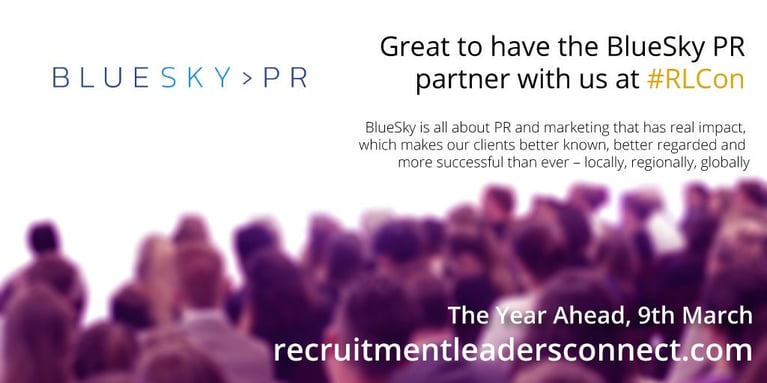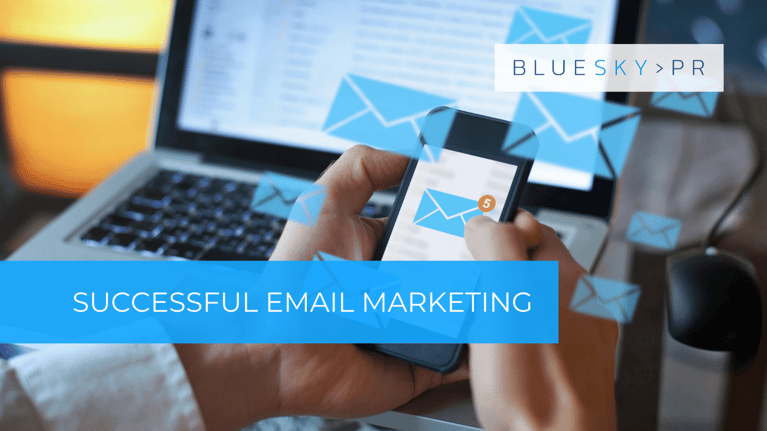
How to use social media for brand building
At a time when the number of global users now exceeds 3 billion, it’s perhaps more important than ever that agencies are using the correct platforms to engage with their target audiences. So here are our top five tips for how to use social media for brand building:
How to encourage your employees to share content
On average, employees have 10 times more followers than their company's social media accounts. We recently shared our 10 top tips for social media success. In the post we stressed that encouraging employees to post and share content about your organisation will increase your reach beyond your own channels, while simultaneously building potential leads and brand perception.
In it for the long-haul: why short-term marketing doesn’t work
Building a brand takes dedication. As well as a great product or service, you need to invest time and resources into spreading your message. There is no quick fix - success relies on a sustained approach. Short-term marketing initiatives are quite frankly, pointless. Of course, there is a place for dedicated campaigns to promote a time sensitive event or initiative, but this should be contextualised within a programme of ongoing communications. You wouldn’t expect to get fit by visiting the gym once – however hard you pushed yourself during your single visit – so why should the results of PR and communications be any different?
Get much more out of a press release
When many think of PR, they instantly think ‘press release’. Well, yes they certainly do form part of the public relations mix, but there is so much more and companies need to be looking to get much more out of a press release and make the most of their PR activities. Is it newsworthy? First and foremost, if you are going to put the time and energy into writing a press release, it really must have a news angle. You might consider the fact that you have launched a new website or refurbished your office is fantastic news, but believe me journalists won’t! Think about what there is an appetite for and craft a release based on this. Your target audience is seeking advice and information on subjects that will help them in their day to day job. Think about what data you have access to – salary levels, skills in demand, pooling & pipelining and diversity - and use that to form a release about the market you operate in. This will have far more appeal and position you as an expert in your respective field. Once you have a good, crucially, newsworthy press release, here are my top tips on how you can get much more out of a press release:

Seven top tips to sharpen your PR writing
I recently blogged on why PR professionals are unlikely to be replaced by robots in the near future. One of the reasons why is the human ability to craft copy to create impact at a time when content can no longer demand attention. Here are my seven top tips to sharpen your PR writing: Get to the point quickly Whether you’re drafting a pitch, press release or article, ensure that your intended message is clear from the outset, or you’ll swiftly lose your audience. Cover all bases PR professionals should always attempt to answer the ‘who’, ‘what’, ‘where’, ‘when’ and ‘why’ in the first sentence or paragraph of every piece they draft in the interest of brevity.
PR or Advertising?
It’s the age-old struggle. In the left corner we have advertising, represented by Mad Men, while in the right we have PR, represented by Absolutely Fabulous. Obviously, in my eyes there’s one clear winner, however it’s probably fair to say that I’m ever so slightly biased. But what is more powerful, PR or advertising? Dated concept It would be unfair to say that advertising doesn’t have its place in the modern world, however to most commentators it’s seen as less effective than it once was in the past. If we rewound to even as recently as 20 years ago, advertising was still a powerful platform and was used to drive the consumer behaviour that organisations wanted. However, back then it was easier to convince buyers to do what you want and it would be fair to say that people were less savvy and, quite possibly, less cynical. Now in the modern, hardened, social media-led world it’s easy to see through often transparent campaigns, which can have damaging effects on firms.

How to write a press release
A press release is the most basic and most important tool for communicating with the media. Why? Simply because journalists and editors have become used to them and know how to deal with them or, in the majority of cases, how to delete them from their inbox. So, how do you write a press release? A good press release encapsulates a story to gain media attention – a bit like a good mailshot in the recruitment sector. As with a mailshot it needs to be targeted, be relevant and communicate quickly and clearly. Here’s an example of one we did for a client which ended up getting both domestic and international coverage over the course of a whole year:

10 tips for social media success
1. Find out where your audience is It can be extremely tempting to create a social media account for your organisation on each of the major platforms. However, doing this means you could be wasting valuable time and resources which would be better spent on the channels that your target audiences are active on. Take time to research this, and decide if creating or maintaining a presence will be beneficial to your overall business objectives.

The General Election and other great sources for content ideas
6 great sources for generating content 1. Your recruitment consultants They talk to candidates and clients on the phone every day. They will certainly have some quirky human-interest stories – they type of thing that they may not even realise is content but actually makes a really interesting story.
Getting ROI from your PR
PR absolutely can and absolutely should be measured. Know what your objectives are. You need to have something to measure against – and so you need context. Do you need more candidates or clients – and where? In a particular sector or geography. Do you need more people to work for you? Do you want to raise you profile as a thought leader? Don’t just share the same message across all channels, think about what you are looking to achieve and the best way to do this using each channel.

How to measure the success of a PR campaign
One of the major gripes that many people have with PR is that it has historically been seen as overly fluffy and often challenging to prove a direct return on investment. For the financial professionals amongst you, that’s probably the number one thing you look for when investing in a service and admittedly, it has been one of the industry’s biggest weaknesses. Historically, the field has been more about creating positive sentiment and raising brand awareness rather than proving direct and measureable financial return from your PR investment. So, how do you measure the success of PR?

Why PR professionals won’t be replaced with robots
The dialogue around robots coming for our jobs has been around for some time now. And as technology continues to advance, many professions have realised that this is the scary truth. However, despite the Office for National Statistics (ONS) reporting that 1.5 million people in England are at high risk of losing their jobs to automation - I’m confident to say that PR professionals won’t be replaced by robots.

The value of PR and content for recruiters
BlueSky PR’s Tracey Barrett recently presented at the Recruitment Leaders Connect conference on “How to make money from PR,” followed by an afternoon of roundtables where we discussed the value of PR and content. So what did we discuss? Why aren’t more recruiters appearing in the press? Often the answer was that they hadn’t been asked and don’t know how to approach the press themselves. But pitching a journalist a story is no different than pitching a client a candidate – the worst they can say is no. However, one of the key things we discussed that that PR isn’t just about the press The press can be a good credibility tick because someone else is writing about you rather than writing about yourself – but everyone can become a publisher these days when we have access to blogging platforms and LinkedIn publisher. So if you’re an organisation that doesn’t have the comfort of a marketing person to represent you to the press on your behalf, you can start just by publishing some posts yourself. It can be as simple as using your LinkedIn publisher platform to start sharing your opinions to stir up some comment and controversy.

Top tips for effective content marketing
I was kindly asked to take part in UK Recruiter’s live webchat on content marketing for recruiters. A few technical blips from my end meant it didn’t really go according to plan – so for those of you who are interested in how to create effective content marketing here are my top tips: Have a strategy It’s essential to determine who you want your content to reach and what the objectives are. Do you want more candidates, clients or even staff for your own business? Do you want to build up talent pools that you can demonstrate your expertise to and tap into for future opportunities? Establishing this will enable you to tailor your content to each specific audience ensuring it is relevant. A strategy will also help dictate what type of content – whether it be blogs, videos, or infographics – are appropriate for each.

Using PR to win the war for recruitment talent
Unless your organisation is an Instagram or a Snapchat and you’ve developed some as yet unidentified method of apparently creating huge amounts of revenue, it’s pretty clear that people are the key to any business. Your employees and what they know are generally what differentiates you from the competition and as much as you might think your fancy CRM, or the PlayStation you have in the kitchen make your company what it is, it’s actually your employees. This makes winning the war for talent – your own talent – absolutely critical and, as we all know, the race is fast and intense in the recruitment industry. Every firm is battling for the best and brightest in the market with the vast majority using little else but salary and bonus options to attract their next critically important employee. That’s clearly not enough and at a time when many of your rivals are likely promising the world and everything in it to their potential employees, you need to go that extra mile to recruit the talent you want. However, fear not, we’re here to help – PR can make all the difference when it comes to recruiting for your own firm. How?

What to write in a press release? Write what you know NOT what you do
Why write about what you know when you want people to know what you do? A good PR company can help raise your business’ profile so you get seen by your target stakeholders. We can do this in a number of ways, such as securing thought leadership articles in sector press, enhancing your company’s blog to attract new audiences and writing press releases which will be distributed to all the key journalists in your industry on behalf of your business. However, too often, companies approach PR thinking their agency will write press releases explicitly about what their organisation does and who they are, but the fact of the matter is journalists don’t care about these things. While this may sound harsh, it is the truth. What they do care about though is what you know and, in particular, the things you know that they don’t. So, here’s what you should be writing about in a press release.

14 email marketing tips for recruiters
When used correctly email marketing can be an extremely effective channel for recruiters to engage with potential candidates and clients. In this blog post, I share some top tips to increase your email marketing effectiveness and optimise performance.

Beware of fake awards
Awards - it's great to be a winner! But... because we all love to win, scam artists have cottoned on and now bombard you with opportunities to show the world that you are the number one ...as decided by... hmmm... who exactly? Recruiters, beware of fake awards.

Being a thought leader: it’s more than just a statement
It’s fairly common these days to see terms such as ‘industry’ or ‘thought leader’ used to describe a brand as a growing number of agencies seek to stand out from the market place and demonstrate that they truly are the best at what they do. But, with so many firms making the same claim, how can one business position its brand as a true thought leader? Here are just a few ways to achieve this through PR activity: Be publically opinionated: If you truly are a ‘thought leader’ you need to have an opinion that is relevant to your audience and you need to share it. By this I don’t mean have a bit of a moan to some of your close contacts in the pub. Instead, choose a number of relevant platforms – from events and conferences to blogs and features – and share your thoughts publically. If clients and candidates see your name in the latest edition of The Pharma Letter, for example, they’ll truly believe your claim to fame.

Making the most of your recruitment blog
It’s almost impossible to find a recruitment agency that doesn’t have a blog these days. Most recruiters are well aware of the many benefits of having a recruitment blog, however few know how to use it properly. So how can you maintain your blog to the best standard without a huge impact on your time? Here are a few tips:

Building a new recruitment website that delivers ROI
Having a beautiful design is great. A recruitment website that delivers on its key objectives is even better. An amalgamation of the two is the dream but takes a clear plan from the start to achieve. When most recruitment firms begin a website upgrade project, their main motivation is the desire for a fresh, new design that better represents their brand – which is clearly important. Their priorities might include improving the way the site performs across the latest browsers and mobile devices, which is fantastic. But neither of these consider what recruitment firms are looking for their recruitment website to provide them with: Candidates applying for their jobs (good, relevant, high calibre candidates) Potential clients getting in touch Recruiters wanting to join their business Achieving these starts long before you hit the page and see the site design. Imagine the people you’re targeting don’t know who you are. That they’re doing a Google search. They’re not looking for you, they’re looking to solve a problem, to answer a question. You need to know what their questions are, what they’re searching for, what to provide them with; you need relevant content, and for that content to be well optimised, in order to be found.

Recruiters: the top 5 candidate attraction mistakes you’re making
Using PR to attract and engage with candidates is a tactic that many recruitment agencies and in-house hiring teams are implementing, but it’s not as simple as just pushing out marketing messages. In fact, there are some common candidate attraction mistakes made: Candidate attraction mistake 1. Talking at people: When you speak to someone on the phone or in a face-to-face environment, you would think it very strange if they simply talked at you, rather than actively engaged with you. Indeed, it’s highly unlikely that you would simply stand in front of a candidate and reel off key information about you, the company and what you think about them, without actually getting to know more about the person. The same can be said of your PR activity on and offline. Blogs and social media use is all about engagement, so make sure you’re sharing your interesting opinions and encouraging people to also provide their views. In doing this, you create more of a rapport with candidates. Candidate attraction mistake 2. Failing to respond: Following on from the above point, ignoring comments and questions on social media channels, blogs or in response to articles will only serve to drive away potential candidates. Even if you disagree with a comment, a response should be made. Of course, it’s vital that you avoid a heated confrontation and instead focus on having a professional debate.

Why share your opinion on the news?
Few people hold back from airing their opinions on current affairs in person. And let’s face it, 2016 and 2017 have been particularly easy years for making small talk. However, while I’m sure you will have shared your firm thoughts on Brexit, Trump or The Great British Bake Off to anyone within earshot, for the majority, this insight will never be broadcast more widely. However, publicly sharing your viewpoints on relevant news stories online can be a fast-track to building your personal brand and, by association, your company’s corporate identity. You can’t become a thought leader without saying what you think While the majority of business leaders now realise the value of social engagement, the content that many organisations produce is formulaic, dry and uninspiring. Perhaps they are just playing it safe, or lack the confidence to open up about their thoughts and feelings, but while liking and sharing the posts of others is a step in the right direction, there really is no substitute for real thought leadership. Don’t just share a story that is of interest to your networks – if it’s really relevant, the chances are they will already have consumed it from the source. Instead, use your own blog, or a third-party platform, to put some meat on the bones. Speak directly to your audience and use your expertise to outline what it means for them specifically. What if my opinion is controversial?

The impact of social media on your employer brand
As recently as a decade ago if you wanted to find out what it was like to work at an organisation you’d have to track down someone who worked there, or hope that the firm had a particularly proactive marketing manager who uploaded information about the employer brand on to the company website. However, times have changed. Now, company information is everywhere and if platforms like LinkedIn, Facebook and Twitter aren’t enough, then firms also have to contend with portals like Glassdoor, which can give the full ‘warts and all’ story whether the company wanted it or not. Simply paying someone a good salary and expecting them to be happy doesn’t cut it anymore. People want a ‘nice’ employer, particularly at the ‘millennial’ end of the market. In fact, 69% of respondents to a Glassdoor survey revealed that they wouldn’t take a job with a company that had a bad reputation and an impressive 84% would consider leaving their current jobs if offered another role with an organisation that had an excellent corporate reputation.

Why love your marketing department?
Time and time again I hear recruitment marketing professionals tell me that they don’t get buy in from their recruitment consultants and are often perceived as a cost to the business rather than an investment in it.

Adding PR into your Marketing Strategy
We all know that content is king and that everyone should have a content marketing plan – and that is very much part of a PR and communications strategy but I would argue that media also needs to be part of that strategy.
Halloween Recruitment Horror Stories
As it’s Halloween it seemed an appropriate time for the team at BlueSky PR to ask recruiters for their scariest candidate experiences. Who knew how frightening it would get… from assault, to lies, to criminal activity. Following the piece in the October issue of Recruitment Grapevine where Clayton Recruitment told tales of non-violent confusion and inappropriate attire, and One Way talked of outrageous excuses, turtle trouble and false teeth, here are a few more stories we’ve been permitted to share: Halloween Recruitment Horror Stories: Spooky “We had candidate come in for interview once who had very long witchy nails and Medusa type hair… we were more than a little intimidated.” - Anonymous Halloween Recruitment Horror Stories: Oooky “We once had a candidate come in to Branch chewing gum. We said that it is okay for a registration, although it is bad practice for interviews. When asking the client for interview feedback, the client informed us the candidate was nervously chewing gum so he asked if it was a habit or whether the candidate just forgot. In a panic, the candidate had apparently then stuck the gum to the bottom of the interview desk!” - Katie Gibson, Director at Pier Recruitment
What Taylor Swift and Justin Bieber Would Read if They Lived in the UK
Media consumption in the UK - what people are reading online and offline Gorkana hosted an insightful webinar this week on what people are reading on and offline in the UK, based on their latest UKPulse media research, and this is what they shared… What are millennials reading? Photo by Jean_Nelson – DepositPhotos.com Sorry to break it to you Kim Kardashian but Gorkana says you’re too old to be a millennial… when Gorkana talks millennials, it’s thinking more Taylor Swift or Justin Bieber (if they lived in the UK), and what they’re reading might surprise you. Millennials regularly read the Times, the Guardian, the Metro, the Economist and Forbes and are more focussed on traditional news topics. Although, you might be less surprised to note that 20% consider BuzzFeed a primary news source. Erica Harris, Senior Account Director at Gorkana, noted that millennials are after authenticity and honesty. They’ll forgive you if you can acknowledge when you’ve done something wrong but if you can’t… Millennials believe traditional media to be more trustworthy than social media but trust in Twitter and blogs has Photo by Jens Muller/Brunopress – DepositPhotos.com grown in the last five years. The sources they trust the most? TV and radio. And the least? Wikipedia. 34% will watch a video if this is embedded in an article. Are you taking full advantage of this additional media opportunity? Do people still read news offline?

26 Recruitment Marketing Tips, Quips and Queries
Takeaways from the Recruitment PR & Content Workshop with BlueSky PR and Barclay Jones Getting ready to kick off the @bluesky_pr & @barclayjones #recruitment #marketing workshop - #RecruitmentMarketing #content #PR # work #workshop A photo posted by BlueSky PR (@bluesky_pr) on Oct 19, 2016 at 1:46am PDT Staff leave – when you buy a business you’re buying the marketing footprint and the data. Figures from APSCo show 61% of recruiters believe next year will be a nightmare for recruiters to hire for their own teams. How do you show your client you’re a specialist? Content. Be a thought leader. The biggest challenge to recruiters is time. Is there a shortage of candidates or just a shortage of interested candidates? 91% of marketers don’t feel that they are effective at measuring ROI. 72% marketers are inconsistent, basic or limited in content marketing. Are your LinkedIn contacts / connection requests increasing since you published that piece of content? That’s your ROI. Marketers, tell your recruiters you've given them their leads, now it’s their job to convert. Are your recruiters targeted on producing marketing content? Do your recruiters know what your marketing department does? Make sure all URLs in your blog posts are trackable. Find out what your clients are interested in outside of work if you want to build a better connection and understand your client demographics. Images boost the chances of your content being read, remembered and shared. Share your content, share your coverage and if in doubt share it again – but don’t spam, remember to customise the post each time. Use click bait headlines but only if you can deliver in the body.

CSR – Nice To Have Or Business Critical?
I have had the honour of being on the judging panel for this year’s APSCo Awards for Excellence and one of my categories was CSR Initiative of the Year. It was a really tough category because, while to the outside world recruiters may often have the reputation of being sharper than a Stanley knife, I was genuinely overcome at the generosity of spirit displayed by all of the contenders – and there were a lot!

Want PR for your recruitment firm? The secret is what you know
In my (far too many) years in recruitment, I have read hundreds of press releases written by recruitment firms – and nine times out of ten they are about what the firm does – not what it knows! Journalists don’t care about what you do – they are interested in what you know. So, what do you know? The people agenda – that’s what! You know about whether pay is going up or going down and why. You know about skill shortages – and what’s driving them. You know about talent pools and where to find them. You know about global comparisons, diversity in the workplace, the future of work, and employability. In short – you know a hell of a lot! And people are interested! If you look at the annual PwC survey of CEOs that comes out every year, it will tell you one of the major things that keep business leaders awake at night is the attraction and retention of great talent. And who knows about that – you do! Recruiters are in a fantastic position to be able to talk about and comment on the issue around the people agenda.
Step away from the email!
In an ever connected world it is all too easy to send a press release to a journalist or email them with an idea for an article. Indeed, I know from the many journalists I’ve built a rapport with that it is a common occurrence for internal marketing, communications and PR teams to fire across multiple emails in the hope of a quick hit. But I implore you, please think before you email that journalist! There are so many considerations you have to ask yourself; is this the right journalist? Is this the right story for the publication? Is this the best way to contact them? Is this the best day to contact them? And so on. But none of this can really be discovered without speaking to the individual – a frustrating catch 22 situation for anyone. And that’s where a good PR firm can add real value. The stereotype of a journalist as an extremely busy individual with short deadlines to meet, an overflowing inbox and an endless stream of nuisance calls is, I’m afraid to say, true. But a good PR agency has not only built a relationship with the right journalists, but also knows when to call. And as my experience at BlueSky PR has taught me, investing the time to build the relationship with these key individuals means that not only do they take our calls with proverbial open arms, but they also call us seeking expert comment and even article ideas.

Engaging in an increasingly digital world
The recruitment industry is all about connecting with people. And with a constantly evolving digital landscape, understanding the best ways to communicate with the various talent pools you want to engage with can be challenging.
Using Media Coverage as a Marketing Tool.
The constant evolution of social media means the way in which we communicate with each other is changing at an accelerating pace. And while traditional media continues to maintain its standing in the industry landscape, sites such as Twitter and Facebook can now boast the advantages of being more up to date and considerably easier to access. Brand Communication As a result social media has become a key pillar of brand communication. On these sites content is often targeted at a specific audience and active engagement is facilitated by the ability to easily share and respond to posts. So in sharing an article you’re not just increasing its reach and making it readily available for your target audience – but also drawing upon the merits of both the social and traditional landscapes, providing your audience with material from dependable sources that can be easily accessed and shared. Brand Engagement The aim of most social media strategies is to encourage potential clients and candidates to engage with the brand, so really the objective should be to direct to users to content on your own website. Posting links to coverage to a news feed on your website and placing them alongside industry specific resources is great way to position yourself as a thought leader.
The press release: much maligned but still important
Some say the press release is dying. Judging by the amount of awful examples peddled to journalists and editors daily many would argue that it’s not dying quickly enough.
Recruitment firms - think social media - think reputation!
As recruiters you have undoubtedly all utilised social media tools to help build and engage with your current and potential client and candidate communities - but how many of you have thought of it as a key element of your reputation management? Let’s take the example of a disgruntled or extremely happy client – if they communicate their experience to others over a coffee then the spread of that message will be quite slow. But with social media those messages can be amplified on an exponential level. If you doing nothing else with social media you should at least be using it to listen because as well as being an amplifier, it is also an enabler. If you can hear what those people are saying about you over their coffee – then you can do something about it!
Giving something back - the value of pro bono
The recent story of Richard Ross falling off the Sunday Times Rich List because he gave away 25% of his wealth to good causes should be a lesson to us all. Giving makes you feel good and while many will say that he could well afford his philanthropy, everyone has the ability to give something of value - even if it is just a good deed. At BlueSky, we like to feel good - and we like our staff to be able to feel good which is why we have decided to undertake a certain amount of pro bono work. There are two projects underway at the moment: The Give Something Back Competition Our business education practice has just launched a really innovative competition for any business school student - or group of students. The idea is that they pitch an imaginative, but robust project designed to improve the lives of disadvantaged people anywhere around the globe. It could be a social enterprise, an educational programme or a humanitarian undertaking. The winner will get 1.5 days of practical PR & media relations support from us per month for six months. And this isn't just a pie in the sky idea. Having worked with business schools the world over, one thing we have learned is that their students often come up with some of the most interesting and innovative ideas to help others in society. From the MBA student who set up a fashion business to help struggling communities in the wake of the Haitian earthquake in 2010, through to the Masters in Management student working to reduce snake bite deaths in Sub-Saharan Africa, we’ve had the privilege of working with a number of exciting projects. We know there are hundreds of great social projects being initiated every year – but that many will get very little attention outside of their immediate communities. We hope to change that and look forward to helping a worthy project get as much press as possible.
Will digital advertising survive?
There have been long debates on the fate of print papers in the digital age. But we missed something vital. If consumers have the choice of blocking online ads, will digital advertising survive? The argument goes like this: as modern society consumes information differently (digitally), news, and implicitly advertising, moves online. The business model is changing – the internet gave users unrestricted access to news and information which in turn put a lot of small papers out of business, while some moved all of their content online. Some newspapers will safeguard their precious content under a paywall but the rest will disseminate it for free and stay afloat from digital advertising revenues. This is old news. But what happens when the digital advertising does not reach its target audience? The Financial Times published a very insightful piece, this morning, on how adblockers are messing up a £120 billion online advertising industry. An adblocker is an application which prevents advertising from appearing on webpages. According to a study by Adobe and PageFair, the number of people using ad blocking software rose 70% last year. Out of 2.8bn internet users worldwide, 144m use adblockers. Media groups such as Google, who depend on advertising – and we’re talking billions of dollars’ worth of revenue, are up in arms over this. Publishers are equally unhappy and we discover that all big digital leaders have developed various ways of fighting adblockers including lawsuits, cash and software. This is just the beginning of a long war between consumers - who feel empowered to use the internet as they wish, software developers who create adblockers, and publishers. My question is where does this leave PR? Hypothetically, if you pay for digital advertising which your target audience then blocks by using software like AdBlock Plus, what is your return on investment? Are adblockers a game changer?

5 top tips for identifying social media platforms for your recruitment business
Social media is an essential tool for recruitment marketers looking to keep their brands front of mind and generate new followers and leads. However, getting started on social media can be difficult especially if you are a new business and are deciding which platforms you should establish a presence on.
5 PR and marketing tips your recruitment business shouldn’t ignore
The top five PR and marketing tips your recruitment business shouldn’t ignore Whilst the recession certainly reduced the size of the UK staffing sector, today’s market is crowded and full of agencies vying to compete with and overtake their competition. Despite this, however, too few look at PR and marketing as a tool to not only differentiate themselves from their competitors, but to also position themselves as the ‘go to agency’ for clients seeking staff and for candidates looking for their next role. There is perhaps a tendency to view marketing and PR as a time consuming and often costly exercise they can do without. Wrong. If done effectively, it can help a staffing company reach its objectives and facilitate growth. Here are my top five tips: Create original, engaging content Perhaps an obvious statement, but any material you create – whether this is a newsletter, mailer, brochure, or media article – needs to not only be compelling, but it also needs to grab the reader’s attention. Like me, most of you will be inundated with content from third parties and, if they fail to draw me in, they not only don’t get read but the brand in question doesn’t strike me as an authoritative voice in their market. Your content needs to be engaging and offer the audience added value. Target your content correctly

The recipe for a monster marketing campaign
As a communications professional for the recruitment industry, I’ve followed the new monster.co.uk marketing campaign with interest. Ask any journalist the recipe for a compelling and engaging story and nine times out of ten they will tell you it needs a human interest angle. No matter how dull the subject matter, if a story talks to real people about issues that affect them, they will a) want to know more and b) want to share it with their friends too. Throw in some interesting statistics and a few celebrities and it becomes even more of a talking point. Monster.co.uk does just this with its ‘Monster Thank You’ campaign. The campaign invites people to thank an individual who has shaped their career, whether it be a colleague, boss, fellow student, teacher, relative or friend, and share their inspirational stories by submitting a message, picture or video via a unique ‘Monster Thank You’ microsite. Make your marketing ‘campaignable’ Not only are these inspirational stories infinitely shareable across social media, but the thank you theme as a whole is highly ‘campaignable’ - a factor in any successful marketing strategy. Not only did Monster raise awareness and drive traffic to its microsite with an above-the-line radio advertising campaign, the brand also supported this with traditional media relations activity by undertaking a survey of 2,000 consumers and 500 employers. This generated press coverage across both tabloid and broadsheet newspapers, as well as the recruitment trade press, and underlined the social media campaign by revealing that Britain is an under thanked and underappreciated nation. At the same time, the social media activity was given more weight and appeal with the addition of a celebrity endorsement by ex-Blur frontman Alex James, who featured in a looping Vine video. An integrated approach works for marketing communications

How will PR look in 10 years?
I remembered reading an article published more than 100 years ago which summarised different views of the future – the one we are living now. I must say that most of those predictions were spot on! People living more than a century ago expected technological advancements but the way things were going back then it was not too hard to predict that after Thomas Edison had invented the first viable light bulb in 1880, the product will only improve. So now, out of a desire to be a step ahead of the game and also test our ability to predict the market, we’ve been asking ourselves how the PR industry will look in a decade. I personally believe that in the next 10 years less developed economies will catch up on the PR concept and start using it accordingly. Probably not much will change in PR in the Western economies (at least not dramatically), but once countries like the BRICS nations begin to appreciate the benefits of PR like we do, we will be witnessing a true internationalisation of the industry. Ian Hawkings ‘’ As the news industry continues to evolve from physical to online, from paid for to free and from in-house to freelance staff, press relations will increasingly be about building relationships with disparate individuals and building them across time zones. Companies, large and small, will only be more interested in winning top-quality press coverage globally to promote themselves in new and growing markets. This will mean PR’s that can appreciate and adapt to different cultural norms, whilst simultaneously maintaining a focus on their clients’ goals, will prosper -whilst those that can’t (or won’t) adapt, will die.’’ Tracey Barrett ‘’ PR will become more about content – already it is not enough just to be read, the objective should be for your content to be shared so when thinking about your PR strategies invest time in your content before investing money in SEO!’’

Q&A with Tony Goodwin, Chairman and Founder of Antal International
Antal International is a global executive recruitment organisation with 110+ offices in more than 35 countries. We caught up with Chairman and Founder Tony Goodwin to see how they use PR to achieve their recruitment goals. Why do we use PR? “In the B2B market it’s vital to place yourself as a thought leader in your industry. A good reputation comes through well considered and thought out views on the marketplace which is exactly what PR gives us. Advertising can often fail to hit the mark, I think it was advertising guru, David Ogilvy who said “50% of advertising is wasted; we just don’t know which 50%”. With PR this doesn’t happen. We know we’re hitting our target audience every time and providing them with meaningful content. Recruitment is an industry based on taking the initiative and sharing opinions and PR allows us to do this.” How do you measure ROI? “It takes a longer term strategy to effectively weigh the value of PR. But we’ve found that the continuity and consistency of our message pays back, which can only help in strengthening our brand. There’s no instant return like a betting company would expect to see from their half time advertising at football matches. But the overall value is much greater. I’m confident that over the course of two years we’ve seen up to a twenty-fold return on our investment. People are influenced by people and by positioning individual figureheads in the public eye we’ve created a voice that the company can base its message around. The results might not be immediate, but PR is a slow-burner and in the long term can do so much more for our business than advertising ever could.”
Case study: From Company Blog Post to Sky News
The company Twenty Recruitment is one of the world’s fastest expanding independent recruitment businesses. In January 2009 while the recruitment sector was suffering from the effects of global financial meltdown, it was rewriting the rule book and setting up the next generation of recruitment business. From a standing start in the very depth of the recession, the company is profitable, has multiple business streams covering 7 industry sectors, a global client base & offices in London and New York. The challenge While BlueSky had secured an impressive level of press coverage in both broadsheet and sector specific press, Twenty was also keen to feature in the broadcast media in order to influence and share opinion on pertinent business issues. The solution BlueSky has always been of the opinion that PR is not just about the press but about creating compelling content that is not only read – but also shared. BlueSky already created content for Twenty’s company blog and ensured that it was disseminated through other channels such as Twitter and LinkedIn. We knew that to get the attention of broadcast journalists we had to contextualise the news and comment on something that there was already an appetite for. As Twenty has a financial services practice – and there were several thousand column inches in the press devoted to the public backlash over bankers’ bonuses and executive pay – we piggybacked this with a blog suggesting that it was time to stop bashing the bankers as the financial services sector was really the only thing left that the UK was any good at! We ensured that it had all the relevant keywords as tags and shared it through LinkedIn and Twitter ensuring that we targeted broadcast social media channels.
Top five PR tips for recruiters
As recruiters look to maintain a competitive advantage, get in front of key clients and attract some of the best candidates, many will turn to PR for support. However, it is all too common to find organisations jumping head first into PR without the necessary in depth planning. Any communications activities such as this are strategic, long term investments which will require a level of forethought in order to be truly successful. So, if you're looking at PR as an option, what do you need to consider? Take a look at our top five tips we shared with TIRA readers:
'Things can only get bitter' when you breach a press embargo
Could there be a worse time for a London Newspaper to get it wrong? The 21st March saw the arrival of the much-anticipated Budget for 2013 – though some managed to see it sooner than intended, as shortly before the Chancellor’s speech was due, the details were revealed on Twitter by the London Evening Standard. The paper had been given details of the Budget’s main themes prior to the speech under a press embargo until later that afternoon. The embargo was still in place when the Standard tweeted a picture of its front page to its followers – a front page full of Budget information. This was unfortunate for all involved, including George Osborne who was faced with the opposition party mockingly waving copies of the front page at him from the benches. Though a swift apology from the editor of the paper was made, and the offending tweet was removed, the damage had already been done. The journalist responsible was suspended, and the newspaper is now rumoured to be denied future access to the exclusive briefings given in advance of both the Budget and the Autumn Statement. For the London Evening Standard, this is a particularly big loss as, being London’s evening newspaper, it was often the first to distribute the news of such events. We often hear about the responsibility those working in PR have to the journalists they communicate with, and the need to be honest and trustworthy, but what about the responsibility the press has towards its sources of information? The Standard’s situation clearly demonstrates how important it is for a journalist to uphold their end of the deal when it comes to handling sensitive information.
The Budget 2013 – what does it mean for recruitment?
This year’s Budget wasn’t without its hitches, and The Evening Standard’s premature publishing of the results will lead to a review on how information is released in the future. It’s clear that George Osborne brought some welcome news to Britain though; September’s 3p fuel duty rise is to be scrapped, beer duty will be cut by 1p, and a 20% tax relief on childcare up to £6,000 per child is to be implemented from 2015. But how have the outcomes affected the recruitment industry?

Why I wouldn't employ Adam!
You've probably heard about the unemployed graduate Adam who blew his last £500 on a billboard ad featuring a huge picture of himself and a link to employadam.com.

Does HR need a re-brand?
Last week saw the human resources and talent management community gather for the annual HR Performance event and - in true HR fashion – the conversations were dynamic and insightful. As usual, there were too many seminars to choose from, though they all had some fantastic feedback on twitter – especially Dave Ulrich and Jon Ingham. However, one of the presentations which I was privy to and particularly intrigued by was a lunchtime debate featuring Martin Tiplady of Chameleon People Solutions, Therese Proctor of Tesco Bank and Norman Pickavance from Morrisons. Martin kicked the debate off with a particularly bold statement which certainly grabbed the attention of the audience. He opened by expressing his annoyance with the fact that HR seems to be one of the only business functions which is constantly explaining what it does and it is time to move on from this. And I have to say, I completely agree. Professionals in this arena are forever justifying their role and at some point this needs to stop. As the three speakers continued to discuss the future for HR, one issue was raised which perhaps explains why the sector is in this situation. When you consider everything HR addresses – from tackling the diversity agenda and employee engagement through to talent attraction and retention – it can cover a huge variety of ‘people issues’. In reality, this perception lacks cohesion. Is there a solution through re-assessing how HR markets itself then? Would the sector benefit from re-marketing what it does into one cohesive brand?

LinkedIn: recommendations vs endorsements
“Nothing says you rock at your job like a LinkedIn Endorsement” was a recent headline in the Chicago Tribune. The article, as the headline suggests, rates the company’s newly launched endorsement function. But is it as good as it’s hyped up to be? Or are recommendations a far more credible addition to a person’s profile?
